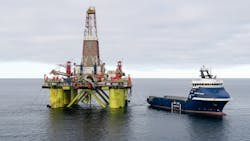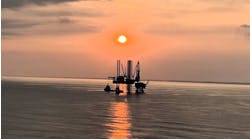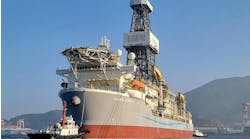Following a tumultuous 2020, last year turned out to be a time of rising oil prices and increased demand for offshore drilling services. While COVID-19 has not gone away, people and businesses are finding ways to work through it. Entering 2022, some drilling jobs that had previously been postponed are now being pursued again, and several rig contractors that had gone through a bankruptcy or restructuring event have reemerged.
Several contractors restructured
Pacific Drilling emerged from bankruptcy on the last day of 2020. Months later, in March 2021, Noble Corp., which itself had just emerged from bankruptcy the previous month, announced it was acquiring Pacific, and the transaction closed in April 2021. Two drillships – Pacific Bora and Pacific Mistral – were divested following this merger. This left the combined company with 24 rigs, comprised of 11 drillships, 1 semisub, and 12 jackups. In November, Noble closed on the sale of four jackups – Noble Roger Lewis, Noble Scott Marks, Noble Joe Knight, and Noble Johnny Whitstine – to ADES International, thereby reducing its fleet to 20 rigs.
Later that same month, Noble once again made a move by announcing a merger with Maersk Drilling. In April 2022, both rig contractors acknowledged the expectation that five jackups will need to be divested to gain approval from the UK's Competition and Markets Authority. The jackups are expected to be Noble Hans Deul, Noble Sam Hartley, Noble Sam Turner, Noble Houston Colbert, and a CJ-70 design unit that is likely to be Maersk Innovator, although Noble and Maersk indicated that Noble Lloyd Noble might be used as the fifth unit. Meanwhile, the merger transaction continues to be expected to close in mid-2022.
Diamond Offshore and Valaris emerged from their respective bankruptcies in April 2021, followed by Seadrill Partners in May. Seadrill Limited did not emerge until February 2022. While neither Diamond nor Valaris have made any moves in the merger or acquisition areas yet, the assets owned by Seadrill Partners, which is now Aquadrill, are managed by Diamond, Energy Drilling, Odfjell Drilling, Seadrill Limited, and Vantage Drilling. Energy Drilling manages the tender-assist rigs, while the others manage the drillships and semisubs.
As of the end of 2021, the ten largest offshore rig contractors managed 44% of the global rig fleet of 723 jackups, semisubs, and drillships. This includes units under construction but not yet delivered. While these companies shed 35 rigs among themselves over the course of the year, all ten companies were also in the top 10 at the end of 2020 for these three rig types. However, there were several juggles within the top 10.
COSL holds onto top spot
China’s COSL retained the top spot as the largest manager of offshore drilling rigs, despite a drop in its fleet of two to 56, and Valaris stayed in the second spot, having reduced its managed fleet from 53 to 51 – for the purposes of this article, jackups leased to the Valaris/Saudi Aramco joint venture ARO Drilling are counted as managed by the ARO Drilling fleet, and the two drillships for which Valaris has a purchase option through the end of 2023 are counted as part of the Valaris fleet.
Even though Transocean’s fleet shrank by five rigs from the end of 2020, the contractor moved from the fourth spot on the list to the third spot. This follows the bankruptcy of Seadrill Limited and Seadrill Partners. Many of the rigs these companies held in 2020 are now managed by other entities. None of the top ten companies added to their fleets in 2021, but Borr Drilling and ADNOC each ended the year with an unchanged rig count from the prior year.
In terms of new construction, the top ten did not make much of a dent in their holdings, with the under-construction count dropping from 16 to 13. However, globally, the number of rigs under construction dropped from 66 to 58. Only a few rigs are still expected to be delivered this year, and those units with work lined up are at the top of the list. Uncommitted units with delivery dates scheduled for this year will likely be rescheduled and pushed out. The contractor on the list with the most exposure to newbuilds is Borr, which has five units yet to be delivered.
Rig sales picked up a bit last year. According to Esgian’s Rig Analytics database, 62 rig sales were completed in 2021, up from 58 the prior year. Sales within the drilling market picked up by seven, while sales for recycling dropped by one and sales for conversion into non-drilling units dropped by two. Jackups were the most popular rig type sold at 38, followed by semisubs at 13, and drillships at 11. Rig sales due to mergers and acquisitions will likely be higher this year as we expect more companies to adjust their portfolios as they seek to build market share and stabilize their positions in their target markets. Rig sales outside the drilling market should slow, in response to rising demand, although units that have been cold stacked for prolonged periods remain candidates for recycling or conversion. In some cases, once rig contractors acquire other units, they are sometimes better positioned to sell off units they have no intention of reactivating.
North Sea/Barents region
By region, the top ten contractors took the biggest hit in the North Sea/Barents region, where they have 14 fewer rigs and ended the year making up just under 61% of the region’s fleet. The group also took hits in the Middle East, dropping to 45% from about 48%, in Latin America, dropping to almost 32% from about 34%; and in the Asia-Pacific region, where they declined a small amount to just under 42% from slightly over 42% the year before. The two regions where the top ten contractors increased their holdings are West Africa, which grew to 73% from 61% based on an increase of three rigs, and the US Gulf of Mexico, which increased to 52% from nearly 49%, based on adding two rigs to the region.
Looking at the regions by their entire fleets, the direction tended to follow that of the top ten managers, decreasing when they decreased and increasing when they increased – with the exception of West Africa. For West Africa, while the top ten added three rigs to their portfolios, the regional fleet fell by three rigs. This is what led to the big change in percentage for the top ten list. While West Africa has been one of the slower regions to rebound following the prolonged downturn, market activity is now quickly picking up, and 2022 is expected to be a more active year in terms of demand.
Working count increases
Moving to the subject of working rigs, as expected, the increase in oil prices last year helped contribute to 33 more rigs working at the end of 2021 than at the end of 2020. Of these 33, fifteen units are managed by contractors on the top ten list. This trend of an increasing working count is expected to continue this year, as the market is experiencing both higher oil and natural gas prices following the Russian invasion of Ukraine, and E&P companies are considering energy security needs when planning their upcoming drilling programs. Some of the key regions to watch for increases in demand are West Africa, Asia-Pacific, and Latin America, while the US Gulf of Mexico should remain strong. The North Sea/Barents region should experience a meaningful uptick in drilling demand directly related to increasing energy security for European countries.
Another change for this year will be the combination of Noble and Maersk Drilling, the number seven and nine spot holders, respectively, on this year’s list. As mentioned earlier, five North Sea jackups are expected to be divested prior to the merger closing. Some, or all, of these rigs may end up outside the region. Depending on any portfolio moves made by the other rig contractors on the list over the rest of this year, the combined Noble-Maersk entity will likely find a spot in the top five.
Given the appetite for jackups in the Middle East, rig contractors in this region are expected to continue adding to their fleets. Middle East contractor ADES is likely to make an appearance on the top ten list for 2022 after it went on a buying spree that started in the second half of 2021 and has yet to show signs of slowing down.
This year has already started out strong for rig contractors with demand and dayrates rising around the world. With many E&P companies flush with cash because of the sharp rise in oil and natural gas prices, and now in light of energy security concerns, some companies are revisiting certain locations or projects that had been shelved as part of the energy transition. Global offshore rig demand is set to finish 2022 higher than it ended 2021. Further consolidation among rig contractors is also anticipated this year, which should result in a shake-up among the top ten list for 2022.




